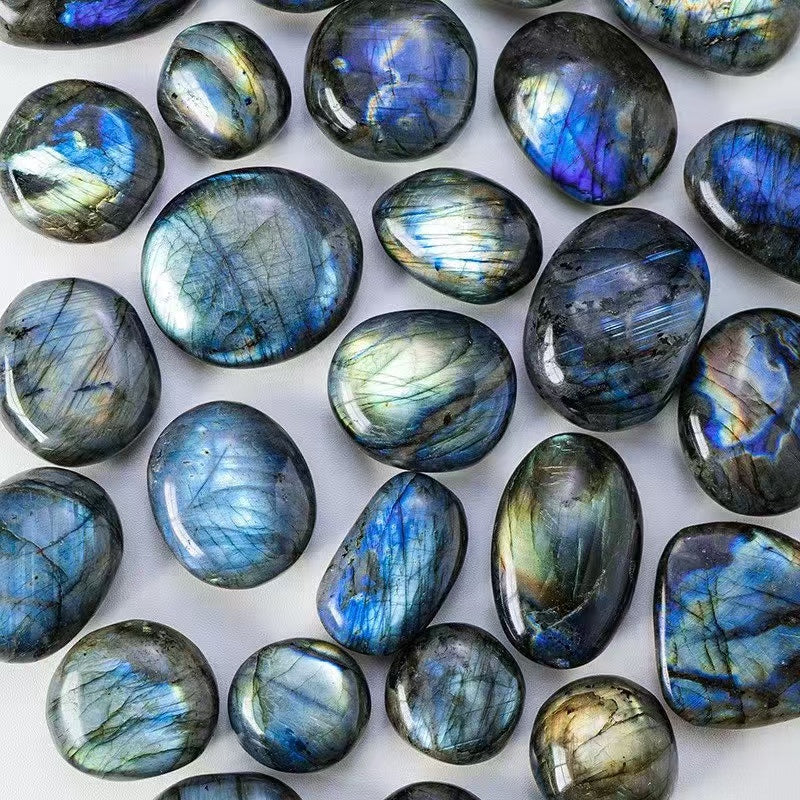Labradorite, a captivating and enigmatic gemstone, has long been cherished for its mesmerizing play of colors and mystical allure. Named after the Labrador Peninsula in Canada, where it was first discovered in 1770, this feldspar mineral has since become a favorite among gem enthusiasts and spiritual seekers alike. Its unique optical properties and rich history make it a stone of both scientific interest and metaphysical significance.
What is Labradorite?
Labradorite is a member of the plagioclase feldspar family, a group of minerals that are among the most abundant in the Earth's crust. It is composed primarily of calcium, sodium, and aluminum silicate, with the chemical formula (Ca,Na)(Al,Si)₄O₈. What sets labradorite apart from other feldspars is its remarkable iridescence, known as labradorescence. This phenomenon occurs when light enters the stone and interacts with its internal structures, causing the light to scatter and produce a dazzling array of colors, including blues, greens, yellows, and even purples.
The Science Behind Labradorescence
The secret to labradorite's iridescence lies in its unique internal structure. The stone is composed of multiple layers of different minerals, which create a series of microscopic interfaces. When light enters the stone, it is refracted and scattered at these interfaces, producing the characteristic play of colors. The thickness and arrangement of these layers determine the specific colors and intensity of the labradorescence. This optical effect is similar to the way a prism disperses light into a rainbow, but in labradorite, the colors appear to shift and change as the stone is viewed from different angles.
Historical and Cultural Significance
Labradorite has a rich history that spans various cultures and traditions. The indigenous Inuit people of Canada believed that labradorite was a gift from the Northern Lights, frozen in stone and imbued with their mystical energy. According to legend, a warrior struck a labradorite rock with his spear, releasing the lights into the sky, but some of the light remained trapped within the stone, giving it its unique appearance.
In addition to its cultural significance, labradorite has been used for centuries in jewelry and decorative objects. Its striking colors and durability make it a popular choice for rings, pendants, and earrings. It is also used in carvings and ornamental pieces, where its iridescence can be fully appreciated.


Metaphysical Properties
Beyond its physical beauty, labradorite is often associated with a range of metaphysical properties. It is sometimes referred to as the "Stone of Magic" or the "Stone of Transformation," believed to enhance intuition, protect against negative energies, and promote spiritual growth. Many people use labradorite in meditation or as a talisman to help them navigate life's challenges and transitions.
In the realm of crystal healing, labradorite is thought to balance and protect the aura, strengthen the immune system, and alleviate stress and anxiety. It is also said to stimulate creativity and imagination, making it a favorite among artists and writers.
Where is Labradorite Found?
While labradorite was first discovered in Canada, it is now found in various locations around the world. Significant deposits have been found in Madagascar, Finland, Russia, and the United States. Each location produces labradorite with slightly different color variations and intensities of labradorescence, adding to the stone's diversity and appeal.
Caring for Labradorite
Labradorite is a relatively durable stone, with a hardness of 6 to 6.5 on the Mohs scale. However, it can be prone to chipping or cracking if subjected to rough handling. To care for labradorite, it is recommended to clean it with mild soap and water, avoiding harsh chemicals or ultrasonic cleaners. Storing it separately from other gemstones can also help prevent scratches and damage.

Conclusion
Labradorite is a gemstone that captivates the eye and stirs the imagination. Its unique play of colors, rich history, and metaphysical properties make it a stone of both beauty and mystery. Whether you are drawn to its scientific intrigue or its spiritual significance, labradorite is a gem that continues to enchant and inspire. As you hold a piece of labradorite in your hand and watch its colors dance in the light, you can't help but feel a connection to the natural world and the wonders it holds.



